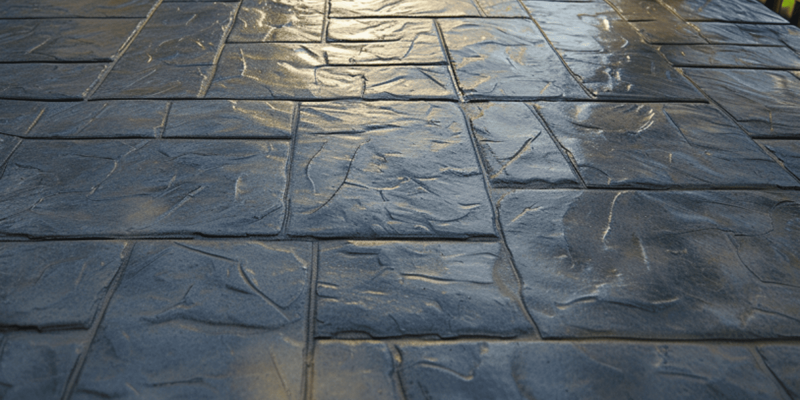Welcome to our guide on stamped concrete, a popular choice for enhancing outdoor spaces. Whether you’re considering a new patio, driveway, or walkway, understanding the benefits and drawbacks of stamped concrete is crucial. This post will provide you with essential insights, helping you make an informed decision for your home.
What is Stamped Concrete?
Stamped concrete is a unique method of imprinting patterns and textures onto freshly poured concrete, mimicking the look of natural stones, bricks, and even wood. This versatile technique involves adding color to the concrete before it’s laid, then pressing molds into it while still wet. The result? A beautiful, durable surface that can transform any outdoor area. Homeowners love stamped concrete for its ability to replicate high-end materials like slate and flagstone without breaking the bank.
Whether you’re aiming for the rustic charm of cobblestone streets or the elegance of natural slate patios, stamped concrete offers endless possibilities. Plus, it’s not just about looks; this material is designed to withstand Illinois’s varied weather, ensuring your investment lasts for years to come.
Pros of Stamped Concrete
Cost-Effectiveness
One of the biggest advantages of stamped concrete is its affordability compared to natural stone, pavers, and other landscaping materials. In Joliet, where homeowners are always looking for cost-effective ways to beautify their homes, stamped concrete offers a budget-friendly solution. The materials and labor for stamped concrete are generally less expensive, making it an attractive option for large areas like driveways, patios, and walkways.
Aesthetic Versatility
Stamped concrete is not just affordable; it’s also incredibly versatile in design. With a wide range of patterns, textures, and colors available, it can easily mimic more expensive materials like natural stone, brick, and even wood. This versatility allows homeowners in Joliet to customize their outdoor spaces to match their home’s style and their personal aesthetic preferences. Whether you’re looking for a sleek, modern look or a traditional, rustic feel, stamped concrete can be tailored to suit any design vision.
Durability and Longevity
Durability is another significant benefit of stamped concrete. When properly installed and maintained, it can last for decades, even under the harsh Illinois weather conditions. Stamped concrete is resistant to traffic, wear, and extreme temperatures, making it an ideal choice for both residential and commercial applications. Additionally, it requires less maintenance than natural stone or pavers, saving homeowners time and money in the long run.
Cons of Stamped Concrete
Cracking Over Time
Despite its durability, stamped concrete is not immune to cracking. Over time, the freeze-thaw cycles common in Illinois can cause stamped concrete to crack. While these cracks can often be minimized or hidden within the pattern, they are still a concern for longevity and aesthetics.
Maintenance Requirements
Stamped concrete requires periodic maintenance to keep it looking its best. This includes resealing the surface every few years to protect against color fading, stains, and wear. The resealing process can be somewhat costly and time-consuming, requiring homeowners to plan for ongoing maintenance costs.
Color Fading and Difficulty in Matching Repairs
While stamped concrete offers a variety of colors and patterns, the color can fade over time due to sun exposure and weather conditions. If repairs are needed, matching the original color can be challenging. This can result in visible patches that detract from the overall appearance of the surface.
Installation Process
The installation of stamped concrete is a meticulous process that requires expertise and precision. It begins with the preparation of the ground, followed by pouring the concrete. While the concrete is still wet, color hardeners and release agents are applied. Then, stamps are pressed into the concrete to create the desired pattern and texture. The area is then left to cure for several days before a sealant is applied to protect the surface.
TIP
Given the complexity of the installation process, hiring a professional contractor with experience in stamped concrete is crucial. Attempting a DIY installation without the necessary skills can lead to disappointing results and costly repairs.
Maintenance and Care
Maintaining stamped concrete involves regular cleaning and periodic resealing. Homeowners should gently wash the surface with soap and water and avoid using harsh chemicals that can strip the sealant. Resealing every 2-3 years helps preserve the color and protect against wear. For minor cracks and repairs, it’s best to consult with a professional to ensure a seamless fix.
Comparing Stamped Concrete to Other Materials
When compared to pavers and natural stone, stamped concrete offers a more affordable and low-maintenance option. However, pavers and stone provide a more authentic look and can be easier to repair individually. Plain concrete, while the most cost-effective, lacks the aesthetic appeal of stamped concrete. Each material has its advantages, making the choice dependent on budget, design preferences, and maintenance willingness.
Conclusion
Stamped concrete is a versatile, durable, and cost-effective option for enhancing outdoor spaces in Joliet, Illinois. While it offers significant benefits, homeowners should also consider its drawbacks and maintenance requirements. Consulting with a professional contractor can help ensure a successful installation that transforms your property while meeting your lifestyle and maintenance preferences.

